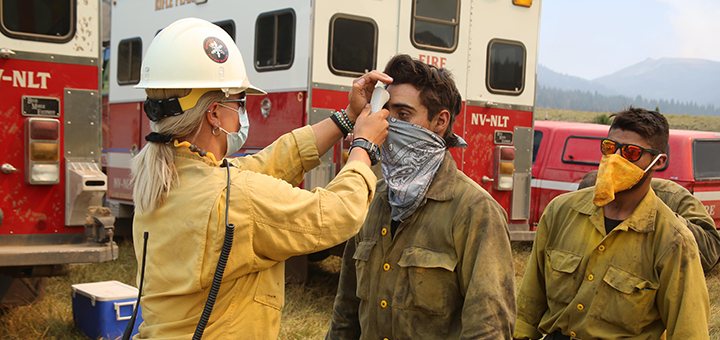Other News Releases
For release: May 7, 2020
Contacts: Kerry Greene, USDA Forest Service, 530-635-0031, [email protected]
Jessica Gardetto, National Interagency Fire Center, 208-957-1355, [email protected]
Area Command Teams develop Wildland Fire Response Plans to protect firefighters
and the public during COVID-19 pandemic
Boise, Idaho — In close coordination with state and local partners, federal wildland fire agencies have developed Wildland Fire Response Plans (WFRP) to help protect firefighters and the public during the COVID-19 pandemic. The plans, which identify issues related to the COVID-19 pandemic and wildland fire response in the United States, guide wildland firefighting efforts throughout the country.
"We developed these plans to improve safe and effective wildland fire response during the COVID-19 pandemic," said Beth Lund, National Multi-Agency Coordinating Group representative for the USDA Forest Service. "As always, our top priority is the safety of wildland firefighters and the public. Wildland firefighting is an activity that requires close physical contact and therefore, we have adapted our operating model to limit virus spread, enhance firefighter safety, and provide for efficient and safe wildland firefighting operations," Lund said.
The plans outline general wildland fire suppression strategies and recommended best practices for all levels of wildland firefighting operations. They also provide guidance to maintain wildland fire response continuity, sustain the highest degree of fire suppression resource availability, and enhance the safety and protection of all wildland fire response personnel. The plans also outline initial fire response efforts, large fire response, and coordination and support functions.
The Area Command teams started working on the plans on March 17, 2020, when the National Multi-Agency Coordinating Group (NMAC) tasked them to coordinate with Federal, State, County, and Tribal officials to identify all issues related to the COVID-19 pandemic and wildland fire response in the United States and to develop a Wildland Fire Response Plan for
each Geographic Area (GA). The teams worked directly with each Geographic Area Coordination Group (GACG) and member agencies to ensure a coordinated plan development effort for each of the ten Geographic Areas in the United States. The plans also follow the Centers for Disease Control and state health department guidelines.
“Often working in adverse conditions, the wildland fire community is accustomed to adjusting quickly to changing situations. Wildland fire responders will continue to adapt as the situation evolves and work in coordination with local and state health organizations,” said Josh Simmons, chairperson of the National Multi-Agency Coordinating Group. “Local fire personnel can use these plans to tailor their fire operations to their respective areas or fire incidents. As the 2020 fire year progresses, these plans ensure a coordinated response that supports our collective mission in wildland fire management while protecting firefighters and the public,” Simmons added.
The plans are available on the web at National Interagency Coordinating Center’s website (https://www.nifc.gov/fireInfo/covid-19.htm).
###
The National Interagency Fire Center (NIFC), located in Boise, Idaho, is the nation's support center for wildland firefighting. Eight different agencies and organizations are part of NIFC including, the Bureau of Land Management, Bureau of Indian Affairs, U.S. Fish and Wildlife Service, National Park Service, U.S. Forest Service, National Weather Service, U.S. Fire Administration, and the National Association of State Foresters.









